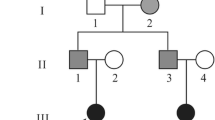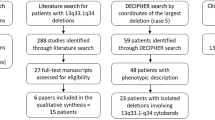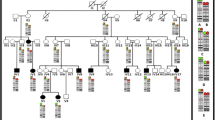Abstract
Emanuel syndrome is caused due to an additional derivative chromosome 22 and is characterized by severe intellectual disability, microcephaly, failure to thrive, preauricular tags or pits, ear anomalies, cleft or high-arched palate, micrognathia, kidney abnormalities, congenital heart defects and genital abnormalities in males. In 99% of the cases, one of the parents is a carrier of balanced translocation between chromosomes 11 and 22. It occurs due to malsegregation of the gametes with 3:1 segregation. In this case series, we describe four patients with diverse manifestations of this condition. The craniosynostosis observed in one case is a novel finding which has never been reported previously. This study aims to widen the phenotypic spectrum of Emanuel syndrome and provide cytogenetic microarray based breakpoints in two of the cases, thus supporting close clustering of the breakpoints of this common recurrent chromosomal rearrangement.




Similar content being viewed by others
References
Agarwal M., Gupta R., Boggula V. R. and Phadke S. R. 2013 Utility of chromosomal microarray in five cases with cytogenetic abnormalities detected by traditional karyotype. Clin. Genet. 84, 600–602.
Carter M. T., St Pierre S. A., Zackai E. H., Emanuel B. S. and Boycott K. M. 2009 Phenotypic delineation of Emanuel syndrome (supernumerary derivative 22 syndrome): clinical features of 63 individuals. Am. J. Med. Genet A. 149A, 1712–1721.
Crolla J. A., Youings S. A., Ennis S. and Jacobs P. A. 2005 Supernumerary marker chromosomes in man: parental origin, mosaicism and maternal age revisited. Eur. J. Hum. Genet. 13, 154–160.
Fraccaro M., Lindsten J., Ford C. E. and Iselius L. 1980 The 11q;22q translocation: a European collaborative analysis of 43 cases. Hum. Genet. 56, 21–51.
Glaser T. S., Rauen K. A., Jeng L. J. and de Alba Campomanes A. G. 2013 Lipodermoid in a patient with Emanuel syndrome. J. AAPOS. 17, 211–213.
Hou J. W. 2003 Supernumerary chromosome marker der(22)t(11;22) resulting from a maternal balanced translocation. Chang Gung Med. J. 26, 48–52.
Kapoor S. 2015 Emanuel syndrome: a rare disorder that is often confused with Kabuki syndrome. J. Pediatr. Neurosci. 10, 194–195.
Kurahashi H. and Emanuel B. S. 2001 Long AT-rich palindromes and the constitutional t(11;22) breakpoint. Hum. Mol. Genet. 10, 2605–2617.
Lin A. E., Bernar J., Chin A. J., Sparkes R. S., Emanuel B. S. and Zackai E. H. 1986 Congenital heart disease in supernumerary der(22), t(11;22) syndrome. Clin. Genet. 29, 269–275.
Ohye T., Inagaki H., Kato T., Tsutsumi M. and Kurahashi H. 2014 Prevalence of Emanuel syndrome: theoretical frequency and surveillance result. Pediatr. Int. 56, 462–466.
Pallotta R., Fusilli P., Ehresmann T., Cinti R., Verrotti A. and Morgese G. 1996 Cerebral defects confirm midline developmental field disturbances in supernumerary der(22), t(11;22) syndrome. Clin. Genet. 50, 411–416.
Rosias P. R., Sijstermans J. M., Theunissen P. M., Pulles-Heintzberger C. F., De Die-Smulders C. E. et al. 2001 Phenotypic variability of the cat eye syndrome. Case report and review of the literature. Genet. Couns. 12, 273–282.
Vorstman J. A., Jalali G. R., Rappaport E. F., Hacker A. M., Scott C. and Emanuel B. S. 2006 MLPA: a rapid, reliable, and sensitive method for detection and analysis of abnormalities of 22q. Hum. Mutat. 27, 814–821.
Zackai E. H. and Emanuel B. S. 1980 Site-specific reciprocal translocation, t(11;22) (q23;q11), in several unrelated families with 3:1 meiotic disjunction. Am. J. Med. Genet. 7, 507–521.
Acknowledgements
We sincerely thank the cooperation of patient families and acknowledge Indian Council of Medical Research, New Delhi for funding (BMS- 63/8/2010).
Author information
Authors and Affiliations
Corresponding author
Additional information
Corresponding editor: Dhavendra Kumar
Rights and permissions
About this article
Cite this article
Saxena, D., Srivastava, P., Tuteja, M. et al. Phenotypic characterization of derivative 22 syndrome: case series and review. J Genet 97, 205–211 (2018). https://doi.org/10.1007/s12041-018-0905-0
Received:
Revised:
Accepted:
Published:
Issue Date:
DOI: https://doi.org/10.1007/s12041-018-0905-0




